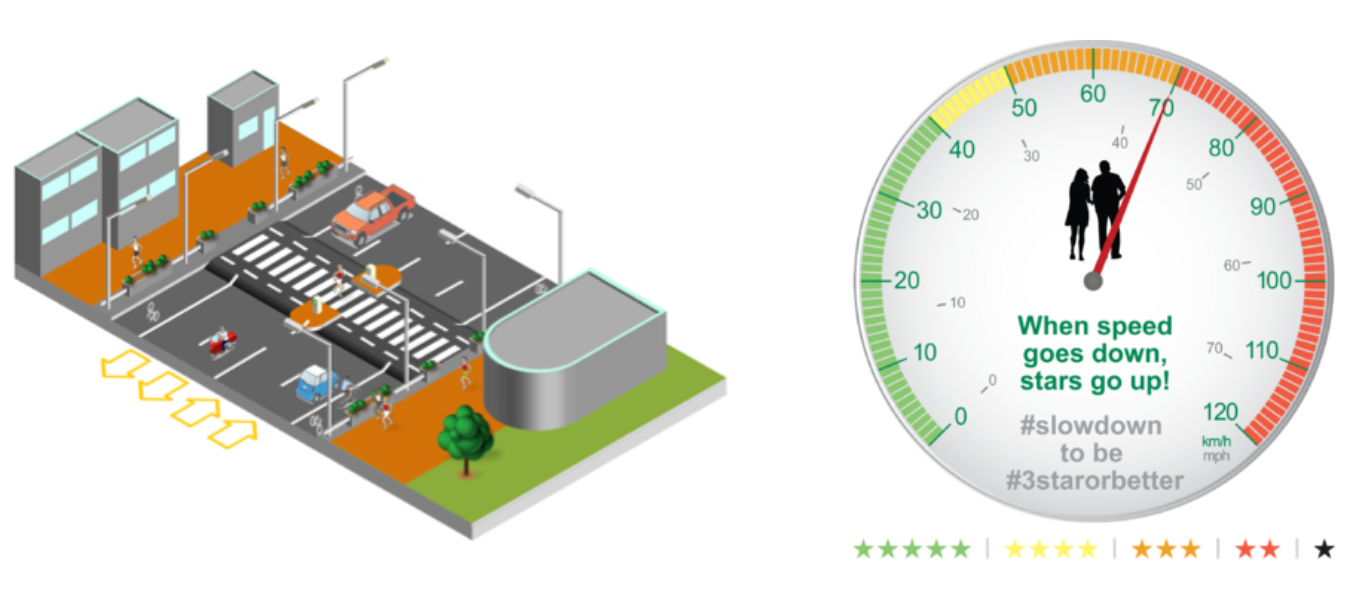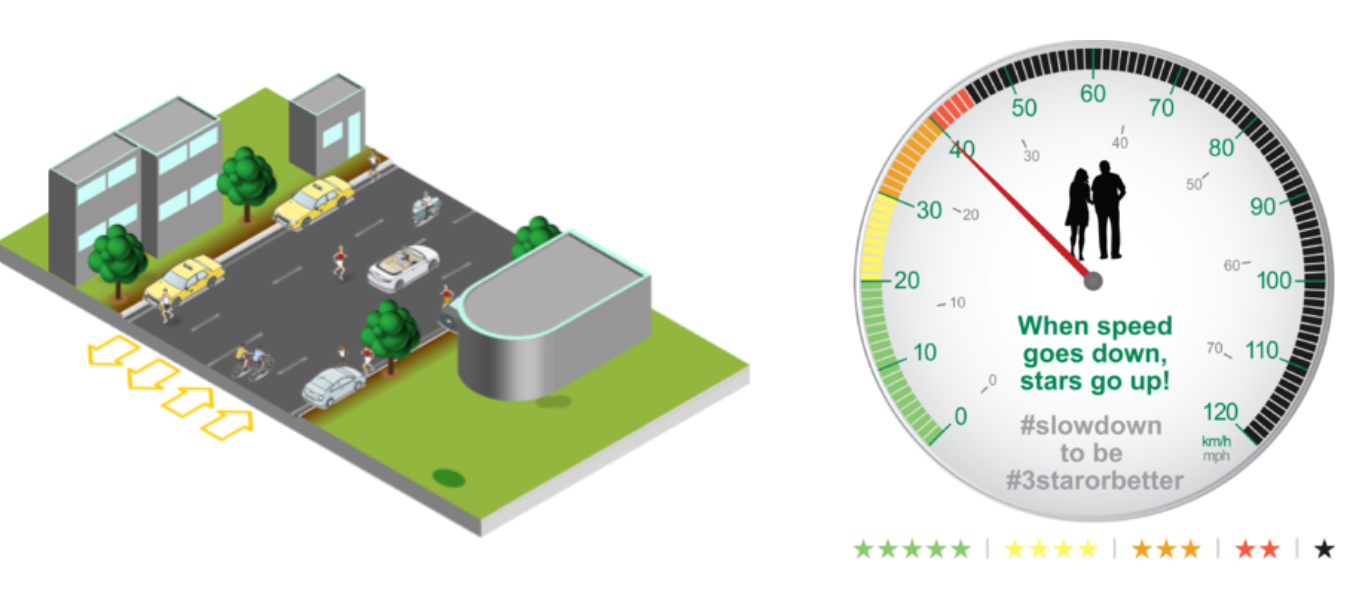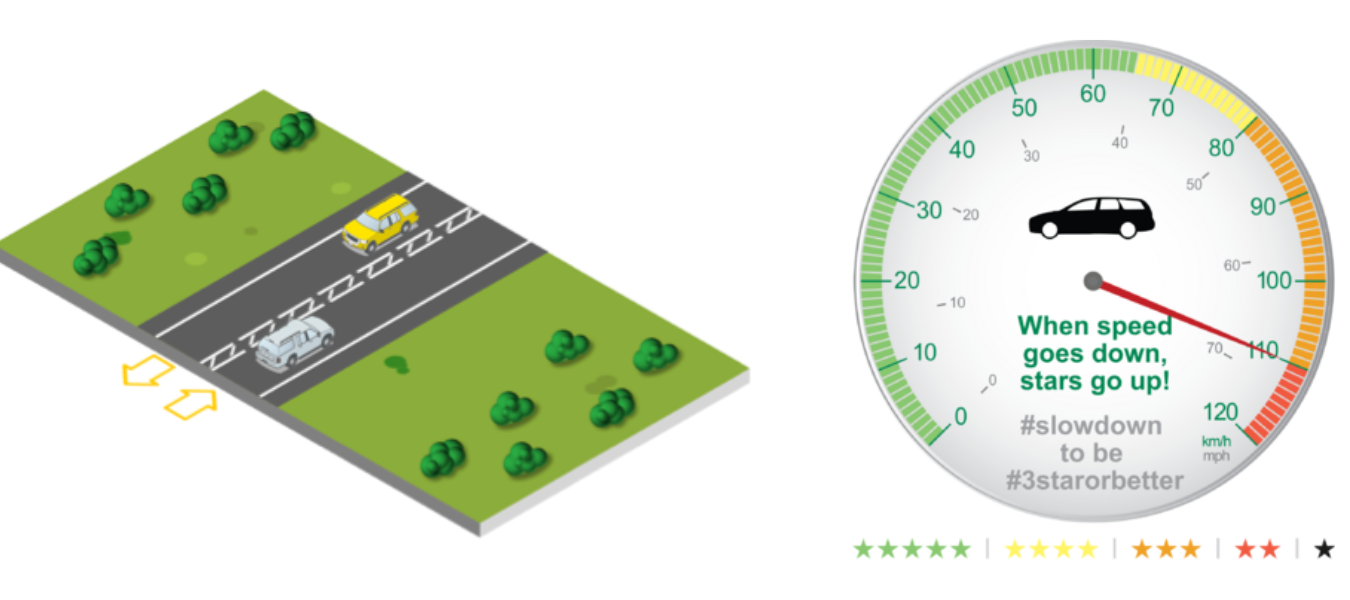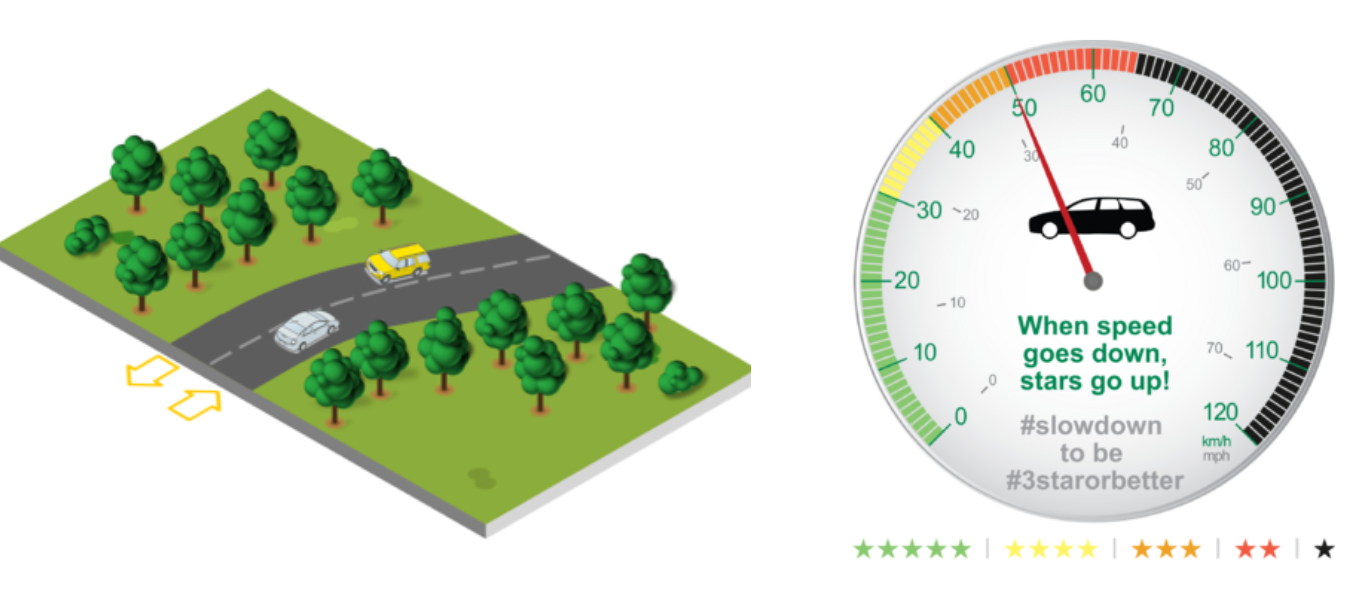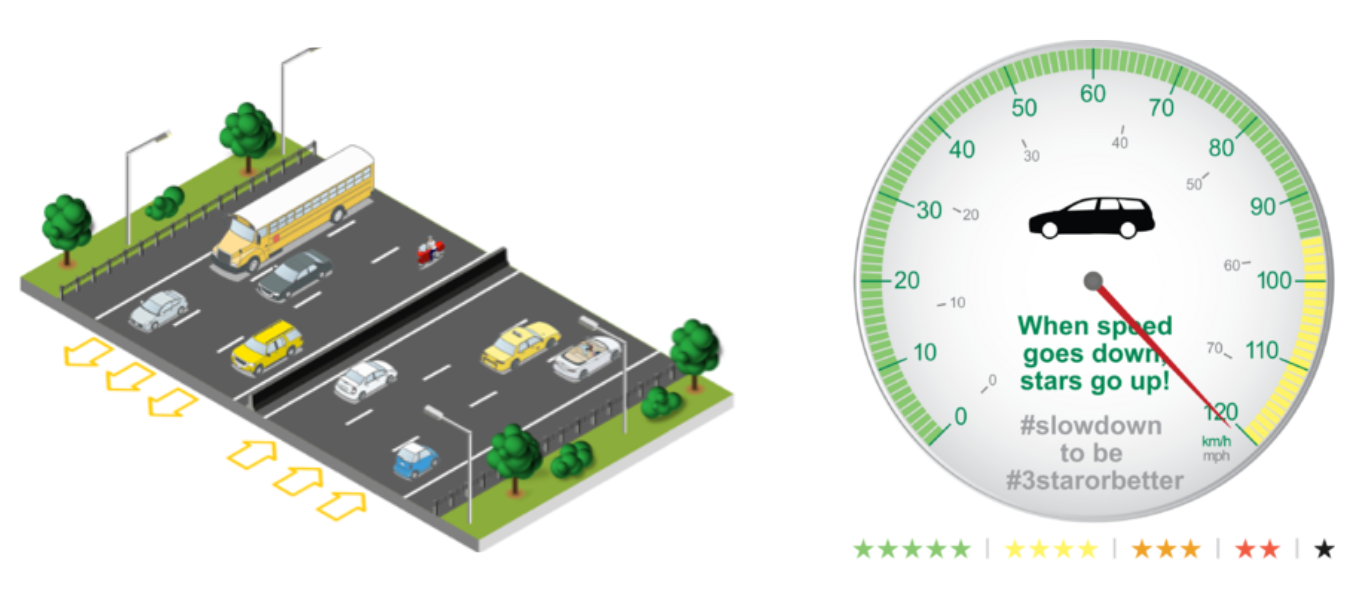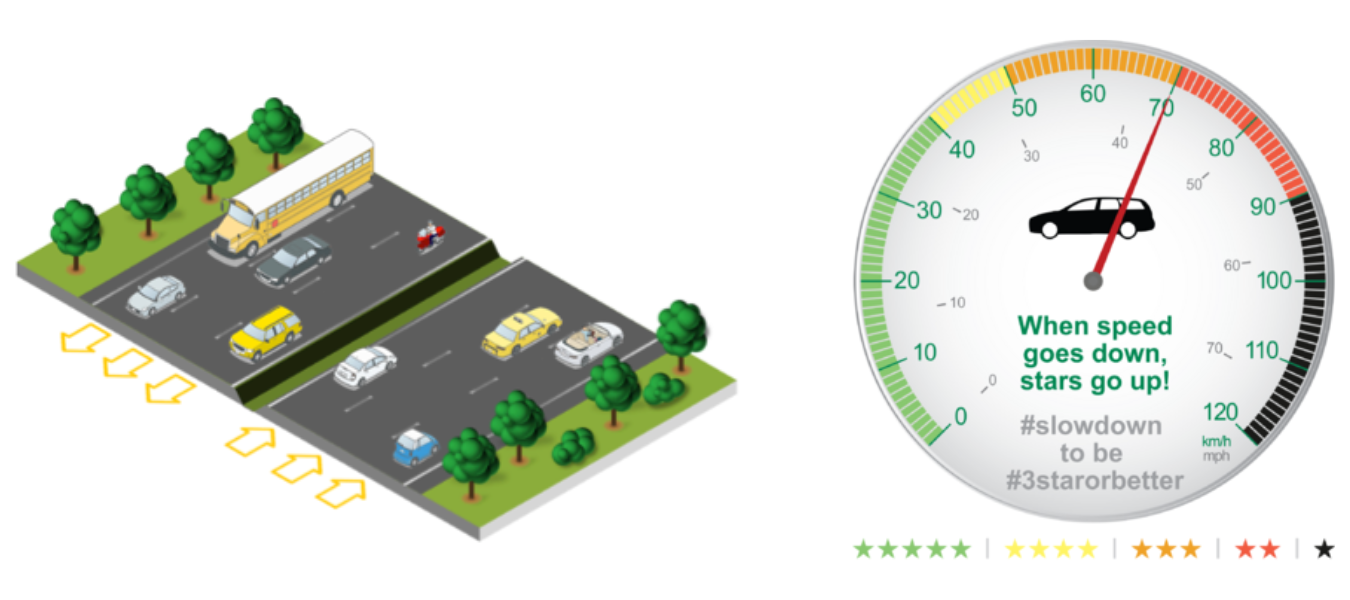
When speed goes down, stars go up!
Speeding is a major risk factor in road crashes. Outcomes of speeding are a matter of physics. The higher the speed, the longer it takes to stop, the more energy in any impact, and the greater the likelihood and severity of a crash. Research shows that a 5% cut in average speed can result in a 30% reduction in the number of fatal road traffic crashes.
Slow down for safety
Speed management must be a part of every road design and every review of existing roads. This can be through the provision of all the safe design features needed to ensure safety at higher speeds or through the active management of vehicle speeds that account for the limitations of road design.
Setting and enforcing appropriate speed limits is also important. 30 km/h in pedestrian zones, 50 km/h at crossroad intersections and 70 km/h on undivided roads are just some examples of safer speeds that minimize the risk of fatality.
Speed, road design and the Star Rating
What speed do you need to travel on each road type to ensure a 3-star or better experience? What road features should you include in a road design to provide a 3-star or better experience for all road users? Explore the relationship between speeds, road design and star ratings in the images below.
URBAN ROADS
Slow Down on high-standard urban roads to be 3-star or better for pedestrians*
When basic features like footpaths, pedestrian fencing, and safe speed-managed crossings are in place a road can be 5-star for pedestrians at low-speeds. Speed management and traffic calming that keeps speeds at or below 50 km/h can ensure a 4-star or better experience for pedestrians.
Slow down more on low-standard urban roads to be 3-star or better for pedestrians*
When footpaths are ineffective or non-existent and crossings are absent or do not effectively slow traffic the risk to pedestrians is hard to manage. Speeds must be 40 km/h or less to provide a 3-star or better experience for pedestrians.
* Intersections have not been included in examples above. Intersections add an extra level of road safety risk and extra care is required at all intersections. Roundabouts that manage speeds effectively through the intersection and grade separated interchanges are safest.
RURAL ROADS
Slow down on high-standard rural roads to be 3-star or better for vehicle occupants*
When a rural road has basic separation of oncoming traffic with central hatching or wide centerlines and when roadsides are relatively free of hazards, the road is straight and well line-marked and intersections are limited, higher speeds can be managed. 3-star or better performance can still be achieved at speeds up to 110 km/h for vehicle occupants.
Slow down more on low-standard rural roads to be 3-star or better for vehicle occupants*
When a rural road is curvy, there is no separation of high speed traffic, road condition and signage is poor and roadsides are full of hazards that can kill, the risk to vehicle occupants is hard to manage. Speeds must be 50km/h or below to ensure a 3-star or better performance.
* Intersections have not been included in examples above. Intersections add an extra level of road safety risk and extra care is required at all intersections. Roundabouts that manage speeds effectively through the intersection and grade separated interchanges are safest.
MOTORWAYS
Slow down on high-standard motorways to be 3-star or better for vehicle occupants*
When a high-standard motorway is provided higher speeds can be managed. Concrete barriers separating oncoming traffic, wire rope barriers protecting roadside hazards, wide shoulders, good line-marking and street lighting all make a big difference to safety. 4-star or better performance can still be achieved at speeds up to 120km/h.
Slow down more on low-standard motorways to be 3-star or better for vehicle occupants*
When a motorway is not designed well speeds must be effectively managed with enforcement. Medians that allow vehicle-cross over or head-on crashes; roadsides with steep drainage channels, embankments or trees and poles; narrow shoulders and poor signage and line-marking all reduce safety. 3-star or better performance is only possible at speeds less than 70km/h or less.
* Intersections have not been included in examples above. Intersections add an extra level of road safety risk and extra care is required at all intersections. Roundabouts that manage speeds effectively through the intersection and grade separated interchanges are safest.
By ensuring speed management is part of every road design and every review of existing roads, and by road users observing speed limits and driving to the conditions, we can make the roads safer for all.
For more information: To explore the impact of speed on the full range of road types and the associated star ratings for pedestrians, cyclists, motorcyclists and vehicle occupants try the Star Rating Demonstrator.
Introduction to iRAP Star Rating Demonstrator tool
Using the Star Rating Demonstrator
Note: Star rating targets used by road agencies worldwide relate to average results over longer sections of road.
iRAP supported the 2017 UN Global Road Safety Week #SlowDown campaign, including in the provision of the text and graphics provided on this page. To manage and reduce speeds we need safe roads, safe vehicles and safe people. For more information on the campaign, and the key solutions for managing speed such as establishing and enforcing speed limit laws, installing technologies in vehicles, and raising awareness about the dangers of speeding as well as the actual speed limit on each road, click here.


